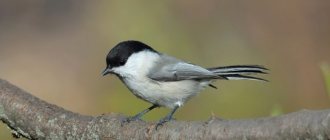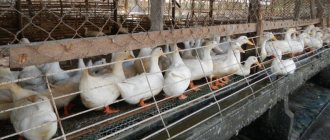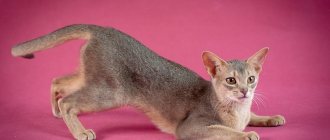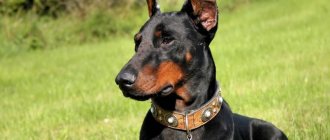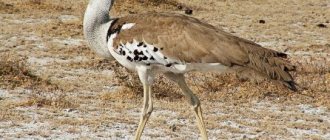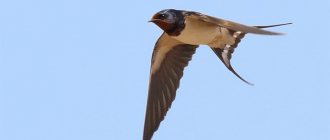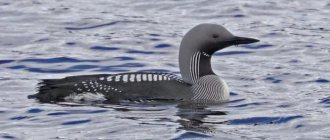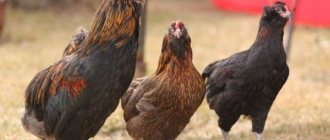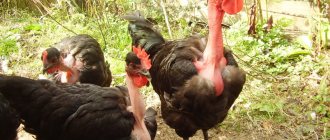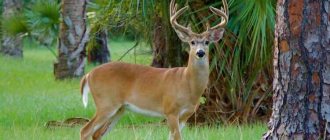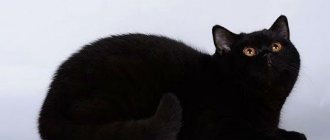Geese are very common poultry that can be successfully bred regardless of climate zone. In popularity they are second only to chickens. They are distinguished by their unpretentiousness to feed and living conditions. They can be raised not only on pastures, but also indoors or even in cages. In the absence of fresh food, they perfectly eat hay, food waste and various root vegetables. In addition, geese have a fairly long life expectancy. At two to three years of age, they not only do not reduce egg production, but also increase it by about twenty percent.
This article contains detailed descriptions of the most popular breeds of geese with photos and characteristic features, as well as key features of these birds that should be taken into account when breeding.
Kholmogorskaya
Photo:
Description: One of the most common breeds in Russia, it was bred by crossing Arzamas and Chinese geese. The first mention of it dates back to 1885.
Kholmogory geese have a recognizable appearance due to the massive bump on their beak, which is formed by 5-6 months of life. Depending on the breed line, the beak may be long, medium or short. There is a large goiter under each jaw, making the neck appear underdeveloped.
The body of the bird is massive and powerful, the wings are long and the chest is well formed. Geese of this breed can be white, gray or gray-piebald in color. The legs and beak are orange.
Males can grow up to 10 kg, females are smaller - 7-9 kg.
Egg production is low, the average is 30 eggs per clutch. Sexual maturity occurs only at 3 years of age; females have a poorly developed brooding instinct; due to their heavy weight, they often break the shell.
Kholmogory are distinguished by a kind and calm disposition, they are not prone to aggression, and can get along with other birds in the yard. They are long-lived among geese; with proper care, they can live up to 17 years. They are unpretentious in nutrition and have good resistance to cold.
Egg representatives
Geese - they eat little, citizens do not trust them due to the presence of diseases, microbes and even worms. The fact is that most farmers use the wrong breed. Therefore, the quality and demand for eggs is low.
If we discard all prejudices, then they are possible and even necessary. They contain a huge amount of protein and minerals that help restore immunity and overall health. Nutritionists even recommend replacing chicken ones with them, they are more filling.
In order not to burn out in this business, the following breeds are distinguished:
- Kuban - not found in the wild. Breeders bred it 100 years ago, for court celebrations and daily food for the nobility. They give about 100 pieces a year. The birth rate is 80%, this is a stable and positive indicator. The geese are small, calm, and have no unpleasant odor. There is an interesting characteristic - you can recognize it by the presence of a small dark bag above the beak.
- Chinese - the name speaks for itself. The difference is that there is a bump on the forehead; it is quite easy to recognize the species. It does not produce as many eggs as the previous species - 75 pieces, but the bird has dietary and tender meat.
Before you are convinced that a goose egg is no worse than a chicken egg, you need to check it. If there are no dents or cracks, then when broken it will not give off an unpleasant odor. The specimen is more filling due to the size of the protein; the average for the selected species is 115 grams.
Lindovskaya (Gorkovskaya)
The breed is a domestic selection, bred through multi-species crossing in 1994. Today, Lindovian geese make up 50% of the entire population in Russia and are widespread in most European countries.
This is a massive and early maturing breed. The body is long and heavy, the wings are tightly pressed to the body. Distinctive features of the bird are a red bump on the forehead, which forms at 7 months, as well as the white color of the plumage. Birds are raised both for meat and for down.
The average weight of Gorky geese is 8 kg. The young quickly gain weight; by 2 weeks of life they can reach 4 kg of weight. Geese are good brood hens; sexual maturity occurs at 6-8 months.
During the laying period, the female lays up to 50 large eggs weighing up to 170 g. The safety of the livestock is 90%. Geese are unpretentious in food and gain weight well both when kept in cages and on pasture. The Lindovsky breed is considered one of the most promising for industrial breeding for meat and fluff.
How to choose?
To choose the right poultry carcass, you should pay attention to the following indicators:
- Skin. It is distinguished by a yellowish-pink color. There should be no damage to the surface. If the skin feels sticky to the touch, the product is spoiled.
- Elasticity of meat. When pressing on the carcass, the resulting hole should quickly return to its previous state. If this does not happen, the goose is stale.
- Carcass size. It is best to take a large bird weighing about 4 kilograms; its meat will be juicy. If you take a small carcass weighing no more than 3 kilograms, most likely the meat will be tough.
- Paw color. A young goose's legs are yellowish, while an old goose's are red.
- Fat. If it is yellow, the meat is “overripe.” In fresh young goose, the subcutaneous fat layer should be either transparent or white.
Meat that meets these criteria will produce a tasty and appetizing dish.
Large gray
Medium-heavy geese bred by domestic breeders in the middle of the last century. This group includes two breeds at once - the Borkovsky and Stepnoy Tambov goose. Today they are actively used for breeding in Ukraine.
Geese of this breed have a medium-sized build. The body is wide, and there are two distinct folds of fat on the abdomen. The wings are powerful and well developed, the head is small; in some individuals a crest is formed, which is not considered a defect in the standard.
The plumage is gray, the presence of white and light gray parts on the body is acceptable. There is a scaly pattern on the back, which is a distinctive feature of the breed.
Males and females practically do not differ in weight; they can grow up to 7 kg. The goslings show rapid growth; by 9 weeks they already weigh up to 4.5 kg. Egg production is only up to 40 large eggs per season. Geese have a developed brooding instinct and cope well with breeding.
These are mobile and active birds. For health, they need a large walking area, preferably with a pond. The large gray goose is not recommended for beginning farmers, since the goslings have poor survival rate, and the birds are picky about food. Adults may display aggressiveness and resentment.
Features of maintenance and care
Geese rearing is divided into summer and winter. In warm seasons, goose meat breeds can be kept outside in pens with a canopy.
It is not necessary to set up a poultry house, because birds go to slaughter at 4–5 months. If poultry is raised for long-term purposes (producing offspring, eggs, fluff and of course additional meat), then during the cold season it is necessary to take care of the poultry house.
Also important is the presence of a reservoir in the pasture or paddock.
Poultry house
It is best to build a poultry house from wooden planks. The main thing is to prevent the formation of gaps between them, since geese do not tolerate drafts well. For these purposes, the building is plastered and whitewashed.
It is advisable to also arrange the floor from wood. The bedding used is sunflower husk, peat, and straw. They change it on average once a week.
A partition is created in the poultry house, dividing it into 2 compartments. One smaller size for sleeping and a larger one for feeding the birds.
Calculation of the room area should take into account that an adult needs about 1 m² for comfortable maintenance.
Inside the poultry house there are drinking bowls, feeders and nests for geese.
Walk
Walking goslings begins 7–10 days after birth. The ideal option is grazing on a pasture with a natural pond. At this time, geese actively consume green food.
When walking on a home yard, it is necessary to fence off the largest possible area, it is good if it is sown with perennial grasses. If this is not the case, then the bird walks in the pen and eats ready-made mash and feed several times a day.
In winter, geese also walk around the territory from which the snow has been previously cleared.
Pond for geese
The most important fact about geese is that they are waterfowl, so they need a body of water for their proper development and health.
The effect of swimming on productivity:
- increases daily weight gain by 30%;
- affects the egg production of geese;
- active movements in water reduce excess fat formation.
For geese, swimming promotes uniform distribution of fat throughout the feathers, cooling the body and preventing pests.
If there is no natural reservoir, then there are several options for how to make it yourself at home.
For a small number of individuals, you can adapt a metal bath or a rubber tire by digging them into the ground.
A large population of geese requires a larger water tank. With your own efforts you can create an artificial pond with a drainage system.
Step-by-step instructions for building a pond:
- Dig a hole under the pond itself. Depth of at least 50 cm, length and width at the discretion of the bird breeder.
- Dig a hole nearby for drainage.
- Dig a trench between the two depressions.
- Lay a brick at the bottom of the future pond, thereby creating a drainage system.
- In the trench, place a drain pipe with a shut-off device and a pipe to drain water into the drain hole.
- Cover the bottom and walls of the reservoir with slate, and place a thick plastic film on top.
- Pour a layer of clay onto the bottom and place broken stone on top of it.
- Decorate the edges of the improvised pond as you wish.
This is the easiest and fastest option for creating an artificial pool. The water must be changed at least once a week.
Tula fighting
Initially, the breed was bred as a fighting breed, so during selection the most aggressive individuals were used. But they were hardy and unpretentious birds with large bodies. As a result, a meat breed was formed, the main disadvantage of which is the grayish color of the carcass.
Birds of this breed have a wide back and a deep chest. The wings are powerful and muscular, the neck is thick. Depending on the shape of the forehead and beak, several lines of the breed will be distinguished (Straight-nosed, Steep-nosed and False-nosed goose). There may be a small, pronounced pouch under the beak.
The plumage is represented by clay, gray and brown-gray colors. Ganders can grow up to 9 kg, geese no more than 7 kg. By 2 months, the young animals gain up to 4 kg of weight.
Egg production is low - up to 25 eggs per season. Females have a maternal instinct, so when breeding at home, you can do without an incubator.
In the course of systematic selection, the initially aggressive nature of birds of this breed became less pronounced. Birds can get along with other abodes of the farmstead and demonstrate high levels of vitality and endurance.
Subtleties of feeding
Kholmogory geese are fed grain mixtures, as well as fresh grass and vegetables. Depending on the season, vitamin supplements, calcium to strengthen egg shells, and crushed gravel are given to help the food grind better in the stomach.
During the breeding period, ganders should be fed high-calorie foods to prevent weight loss. At the same time, it is necessary to ensure that the gander and geese from the parent flock (intended for breeding offspring) do not become overweight. This does not contribute to effective fertilization and subsequent egg production.
The goose barn must be equipped with feeders and drinkers. They should be enough for the entire livestock. Daily diet of an adult goose:
- about 700 g of grain feed;
- about 500 g of root vegetables (potatoes, carrots);
- about 300 g of herbal flour.
Newborn goslings are given crushed food - boiled eggs and grain. The mixtures should not be sticky, otherwise they may clog the gosling's airways and he will suffocate. The gosling should eat at least 50 g of food per day. Every day the volume of feed increases.
Danish Legart
The breed was bred by Danish breeders; in appearance the birds are similar to Italian and Emdem geese. They are loved by farmers for their friendly disposition and fast ripening. Legarts are squat and heavy geese, the body is slightly elongated. The neck is of medium length, there is a small layer of fat on the abdomen.
A distinctive feature of the breed is its blue-gray eyes and snow-white plumage. Black spots on feathers are allowed only in young animals.
Males can grow up to 8 kg; geese are almost as heavy as them. The young quickly gain weight; by the age of 2 months they can weigh up to 6 kg.
Sexual maturity occurs at the age of 250-270 days. Egg production is low - 40 eggs per season, their weight can reach up to 200 g. Maternal instinct is poorly developed, the survival rate of young animals does not exceed 60%. Birds of this breed are unpretentious in terms of living conditions and nutrition. They gain weight well even on green food. The fluff yield reaches 0.5 kg per individual.
Chinese
Today this breed is practically not used for production. However, Chinese geese are actively used to produce new highly productive crosses and other breeds.
Outwardly, it is a light bird, distinguished by its long neck and medium-sized build. The body is ovoid, slightly raised in front. The chest is rounded, the paws are of medium length.
The plumage can be white or gray-brown. The beak and growth on it are orange. The neck is long, in some individuals it may resemble a swan.
Males can reach 5.5 kg in weight, females are slightly smaller. Egg production is up to 80 eggs per season. Geese do not have maternal instinct, so breeding requires an incubator; hatchability of young animals is 75%.
Chinese geese are hardy and unpretentious birds. At the same time, they have an uncooperative character, often scream and can demonstrate aggression towards other farm animals.
Kubanskaya
The breed was bred in the Kuban by crossing Chinese and Lindovian geese. Widely used for cultivation in Ukraine and Moldova. It has low meat productivity, but demonstrates excellent reproductive qualities; as a result, even from several individuals you can get a large herd.
Kuban geese have a medium-length body, a large head and a rounded chest. On the large head there is a dark-colored frontal bump. The main color of the plumage is gray-brown, with a dark brown stripe on the neck and head.
Adult ganders can grow up to 5.5 kg, females are practically no different from them. In the first two months, the young animals gain up to 3.5 kg. During the laying period, females produce up to 90 eggs weighing about 150 g. The hatchability and safety of the young are high, but geese are poor brood hens.
Kuban geese are not suitable for growing in the north, as they do not tolerate cold well. They differ in the gray color of the carcass, which is a significant drawback. Birds are aggressive and can hiss and scream without any visible danger.
Productivity
As mentioned above, Kuban geese were bred more as an egg breed. Geese begin to lay eggs around the 240th day of their life.
The shell of the egg is usually pale milky in color, and the egg itself weighs from 130 to 160 grams. The eggs of Kuban geese have excellent taste.
They are hearty, tasty, with a large yolk. In a year, a young goose can lay up to 90 eggs, which is an excellent result compared to other breeds. Continuation of egg production - up to 7 months.
A plus is the high hatchability rate of eggs - up to 90%, and newborn goslings have a fairly high survival rate. As geese age, their egg production declines, so geese are kept for up to four years to obtain eggs.
The Kuban meat is tasty and nutritious, but its quality is influenced by the diet of the birds.
Kuban geese meat is well suited for drying and smoking.
Goose liver is a valuable product; it can even be called a delicacy, and goose fat contains a large amount of unsaturated fatty acids necessary for humans.
A properly formulated diet is an important factor in the viability and egg production of Kuban geese.
In summer, adults need about 2 kg of greens per day, at the same time the birds are fed with grain. Kuban geese prefer young grain crops and will refuse low-quality feed.
The basis of feeding birds in winter is compound feed, grain, silage and vegetables. During the cold season, it is also useful to include pine needles in your diet.
In addition to the fact that the needles contain a lot of vitamins, they will help geese get rid of parasites.
To increase the digestibility of food, birds need to include coarse sand and seashells in their diet.
Carefully! You should not feed potato sprouts to geese; they are poisonous and, as a rule, cause severe poisoning. In summer, at high temperatures, the amount of feed is slightly reduced, in winter, with the onset of cold weather, on the contrary, it is increased
In summer, at high temperatures, the amount of feed is slightly reduced, in winter, with the onset of cold weather, on the contrary, it is increased
In summer, at high temperatures, the amount of feed is slightly reduced; in winter, with the onset of cold weather, on the contrary, it is increased.
It is necessary to ensure that the birds' feeder is always filled, because they eat even at night.
Landskaya
The breed was bred in France; Toulouse geese were used as mother animals. Today it is actively grown in many European countries, popular due to its large liver, from which foie gras is subsequently prepared.
Geese of this breed have a short and wide neck, a powerful build and distinct fatty bags on the body. There is a light gray scaly pattern on the wings, body, neck and head.
The beak and paws are red-orange. Adults can grow up to 8-10 kg, young animals quickly gain weight and by 2 months weigh up to 5 kg.
Females are good brood hens and produce up to 35 eggs per season. At the same time, hatchability is low, rarely exceeding 50%. Ganders have a courageous character and try to protect their flock. Birds are unpretentious in rearing and are used for breeding new breeds.
Shadrinskaya (Ural)
The breed has been known for more than 300 years, bred in the Perm region. They are poorly productive birds, but are often used as a basis for the development of new breeds.
Ural geese have a small short body and small dimensions. The body is slightly lowered down, the paws are short but wide. Depending on the variety, the plumage color can be gray, piebald or white. There is a light-colored fat fold on the abdomen.
Males reach 6.5 kg in weight at adulthood, females weigh no more than 5 kg. The young quickly gain weight, growing to 5 kg by 2 months. In one season, the goose lays up to 30 large eggs and has a developed brooding instinct.
Birds of this breed feel best when kept on pasture; raising them in aviaries is not recommended. They adapt to unfavorable climatic conditions and are suitable for breeding in the harsh conditions of the Urals and Siberia.
Diet
When keeping birds on pasture, when they are constantly walking among fresh grass, the geese are fed once in the evening. Birds eat an average of 2 kg of green food per day, which provides their body with vitamins, minerals and fiber. For nutritional value and replenishment of other useful substances, geese are given wet mash with vegetables and coarse grain feed at night.
For comfortable digestion, sand, gravel, chalk and shell rock are added to the feed. Free access to fresh water is also necessary. Geese quench their thirst and periodically caress their nostrils.
In winter, the bird has three meals a day. Daily food ration:
- Morning – 1/3 of the daily norm of flour mixture and sprouted grains;
- Noon – raw sugar beets, boiled potatoes, chopped hay and vitamin-mineral ready-made feed;
- Evening – 2/3 of the daily norm of flour and grains
The table shows the daily norms for food products:
| Ingredient | Quantity |
| Potatoes and sugar beets | Total 500 gr. |
| Cereals | From 75 gr. |
| Chopped hay | 150 gr. |
| Carrot | 100 gr. |
| Mineral feed | 25 gr. |
It is better to feed geese with wet mash and avoid whole grains; it is better to use it in the form of granules.
A month before the female begins to lay eggs, she is transferred to an intensive fattening regime. Bone and fish meal, legumes and more hay are added to the usual diet. During this period, the goose should eat 4 times a day.
Hungarian
They are considered a universal breed of geese; they are raised both for meat, down, and liver. Crossing with the Landish breed is especially effective, due to which the liver becomes fattier and larger.
Birds have a compact and wide body and a rounded chest. The legs are powerful and massive, colored orange. The neck is long, on which is located a medium-sized head with a red-orange beak.
The plumage color is only white, all other shades are defective from the breed standard. Adult males can grow up to 7 kg, females are 1 kg less. By the age of 2 months, young animals gain up to 4.5 kg of weight. Geese can produce up to 40 eggs per season, the hatchability of which is 70%. At the same time, the safety of young animals can reach up to 95%.
The maintenance of this breed depends on the production purposes. With pasture breeding, up to 110 g of fluff can be achieved per individual. The birds are unpretentious to food and rarely show aggression.
Classification and review of popular breeds
Geese began to be domesticated in ancient Rome. They are still in demand to this day, because they are a source of healthy lean meat, delicious liver and large, high-quality eggs, which, along with chicken, are used in cooking. In the 3rd month of life, the bird can reach from 5 to 15 kg, it all depends on the species.
Geese breeds are usually divided into 3 weight categories:
- Heavy - meat-fat.
- Medium – decorative.
- Light - egg-laying.
Not every bird is suitable for home breeding, because many broilers lack the instinct of motherhood. Therefore, it is important to understand for what needs this or that variety of geese is better suited.
Governor's
One of the youngest breeds of geese. Bred in 2011 by domestic breeders based on the Italian and Shadrinsk breeds. Birds are popular among farmers due to their early maturity and high safety of the young.
Birds have a compact, rounded body. The wings are of medium length, tightly pressed to the body. The small head is located on a long and powerful neck, the beak and paws are orange. The color of the plumage is only white, the down has high thermal insulation qualities, and therefore has a high price on the market.
Males and females hardly differ in weight; they can grow up to 4-4.5 kg. During active oviposition, a goose lays up to 50 eggs. The safety of young animals is very high, reaching 95%. Birds have a calm character and are able to adapt even to unfavorable living conditions.
Italian
An old breed of geese that gave rise to many modern varieties. The birds are prized for their tasty meat and large, fatty liver, which is ideal for making foie gras. It’s hard not to notice Italian geese in your backyard.
They have a small and neat body, proportional body sizes. The wings are powerful and fit tightly to the body. The neck is long and elongated. It has a movable head with a light orange beak.
Females and males weigh approximately the same and can grow up to 7 kg. The young develop quickly, gaining up to 4 kg of weight by 2 months. Geese reach sexual maturity by the 240th day of life, and can lay up to 50 large eggs per season.
The hatchability of goslings reaches 70%. When keeping, you can do without a pond; the birds feel good even on a limited pasture. They demonstrate independence and rarely come into contact with other inhabitants of the farm.
Bird breeding
For novice poultry farmers, it is better to start raising the largest breeds of geese. And choose from them the least whimsical content.
Requirements for eggs for hatching goslings:
- They must be fertilized. On the 6th day after laying, they are translucent, a dark dot should be visible.
- Select eggs without defects and of the same regular shape.
Before laying eggs, you can wipe them with hydrogen peroxide.
With a hen
An experienced goose is best suited for the role of a hen. But you can also prepare a young female. For this:
- Place a few eggs in her nest for a couple of days.
- Organize peace and quiet around her.
- After this, a check takes place. If the goose has not left its nest, and shows aggression by driving the person away from itself, then it will be able to hatch the eggs.
The goslings hatch after 4 weeks. After birth, they must dry off with their mother, then the female can be removed from the nest.
Incubation
Farmers prefer to breed almost all breeds of geese in incubators. The main criterion here is the temperature, it should always be at the level of 37.5 – 37.7°C. From the 15th day of incubation, the temperature is reduced to 30°C daily for 30 minutes.
For unborn goslings in eggs, air ventilation inside the incubator is very important. They need 12 times more oxygen than chickens.
Toulouse
One of the most ancient breeds in the world. The birds were bred by French breeders by gradually crossing wild gray geese. Despite the difficulty in keeping and breeding, this breed is the most popular in America. Poultry meat and liver are of excellent quality and are highly valued in the market.
Geese of this breed are large and massive birds with a voluminous, wide body. The neck is long and thick, there are folds of fat on the body and under the beak.
The plumage is dark gray or fawn, the beak and paws are dark yellow. Males can grow up to 10 kg, females only up to 6-7. By the age of 2 months, young animals gain up to 4 kg of weight. Egg production is only 35 eggs weighing up to 190 g. The hatchability of young animals is low - 60%, geese are poor brood hens.
Typically, Toulouse geese are kept only for fattening to obtain a large amount of meat products. Pasture keeping is not suitable for them, as the birds are sedentary and lazy. They have poor resistance to frost and are sensitive to humidity.
Emdenskaya
A classic breed of geese, bred by German breeders. Emden geese are the basis for many modern meat breeds. It has high meat productivity, the meat has a pleasant taste and low fat content.
Birds have a long and powerful body with a fatty fold on the abdomen. The neck is strong and thick, with a large head on it. The beak is wide, painted in a rich orange color.
The legs are massive, but short, due to which the bird’s specific gait appears. Males can reach 11 kg, females are slightly smaller - 9 kg. The young gain up to 4 kg of weight in 2 months. Egg production is only 45 eggs per season, the incubation instinct is not developed.
The birds are unpretentious to their living conditions and quickly gain weight on almost any type of feeding. Adults are a real decoration of the site, and their white or gray fluff is highly valued on the market.
Diseases of geese
There is a breed of geese that is characterized by strong immunity and resistance to parasites. But due to improper living conditions (drafts, dampness, dirt, poor-quality food, temperature changes), the bird may begin to get sick.
The table shows the main ailments and their manifestations:
| Disease | Symptoms |
| Viral enteritis | Lethargy, the bird is freezing, sudden freezing, bloody diarrhea |
| Colibacillosis | Diarrhea, thirst, lethargy, drowsiness |
| Salmonella | Diarrhea, lethargy, drowsiness, thirst, eyes constantly closed |
| Pastorellosis | Wheezing, depression, loss of appetite, thirst, bloody droppings, mucus from the nose |
| Esophageal blockage | Constantly open beak, restlessness, staggering, weakness, shortness of breath |
Treatment
Timely treatment can save the lives of geese and prevent the spread of the disease to the entire population. However, to understand the bird’s condition and choose the right treatment, a veterinarian’s consultation is necessary.
The table provides introductory information on methods of treating diseases in geese:
| Disease | Medicine | Description of the medicine |
| Salmonella | Antibacterial drugs | Use nitrofuran derivatives - furazolidone |
| Colibacillosis | Broad-spectrum antibacterial drugs | The drug Baytril. Active ingredient – Enrofloxacin |
| Pastorellosis | Broad-spectrum antibiotics and sulfonamides | The penicillin group is the drug bicillin-3, the chloramphenicol group is the drug Levomycetin. |
| Esophageal blockage | 50 ml of vegetable oil inside. Next, gently pressing with your fingers, remove the stuck element from the esophagus. | The oil acts as a protection against scratches and improves glide. |
| Echinostomatidosis parasites | Antihelminthic drugs | Active ingredient: niclosamide |
Vladimir clayey
Photo:
One of the most unpopular breeds of geese, bred by domestic breeders. The birds have a gray-brown plumage color, which leads to the characteristic shade of the carcass.
At the same time, the meat yield is high, males can grow up to 8.5 kg, females weigh no more than 7.5 kg. Egg production is 50 eggs per season; geese are good brood hens. The hatchability of offspring does not exceed 50%.
The breed is considered unpromising for industrial cultivation, but Vladimir geese can often be found on private farmsteads. The birds have a friendly disposition and adapt to unfavorable climates.
Geese are considered rare birds in the garden. They are considered to be aggressive and do not get along well with other animals.
When choosing a breed, you need to take into account not only the character of the goose, but also its characteristics - fluff yield, egg production and meat productivity. Most species quickly replenish the flock, so rearing is one of the most profitable types of poultry farming.
